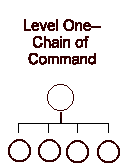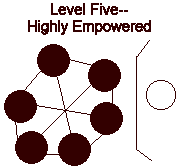Transformative Leadership
 A presentation given by Dr. Elizabeth Lolly at the 1996 Ohio Literacy Resource Center Leadership Institute.
A presentation given by Dr. Elizabeth Lolly at the 1996 Ohio Literacy Resource Center Leadership Institute.
Instructions
Take a minute to do an assessment
of your strength in the Leadership Empowerment Principles
. Read
the statements that describe some of the key skills and actions
needed to apply each principle and then indicate whether this
principle is an area of strength for you or one in which you would
like to improve. At the end of the self assessment you should be able to
see key areas of strength and key areas which need improvement.
1. Let go of things
others can do.
- Let go of tasks and responsibilities
that will help others develop.
- Let go of authority to make decisions
about the work.
- Know what others in the group
can do and want to do.
- Build people's skills to take
over by involving them in the work.
This is an area of strength for
me.
This is an area in which I would
like to improve.
2.
Encourage initiative, Ideas, and risk taking.
- Actively seek ideas and suggestions
from the work group.
- Allow people to run with
an idea, even if it might involve some risk.
- Reward and recognize ideas and
initiative through compliments, formal recognition, and, whenever
possible, tangible rewards.
- Are careful not to put down or
discount ideas.
This is an area of strength for
me.
This is an area in which I would
like to improve.
3.
Ensure that people have goals and know how they're doing.
- Encourage the work group to take
a lead role in setting goals and assessing their own performance.
- Ensure that goals are clear
and understandable.
- Let people know how they're
doing in meeting goals and provide the guidance and support they
need to meet them.
This is an area of strength for
me.
This is an area in which I would
like to improve.
4.
Delegate to challenge, develop, and empower.
- Delegate to challenge and develop
people.
- Delegate authority to make decisions
about the work.
- Provide a clear understanding
of the responsibility, amount of authority, expectations, and
constraints.
- Support the delegation within
and outside the work group.
- Set up controls that keep themselves
apprised of progress but aren't seen as restrictive.
This is an area of strength for me.
This is an area in which I would
like to improve.
5. Coach to ensure success.
- Coach before the person
begins the task or assumes the responsibility and along the
way as needed.
- Make coaching a regular part
of their jobs.
- Are good coaches-their coaching
sessions guide and instruct, while maintaining or enhancing the
self-esteem of the person being coached.
This is an area of strength for
me.
This is an area in which I would
like to improve.
6.
Reinforce good work and good attempts.
- Use verbal praise frequently.
- Know the kind of reinforcement
that works best for each person.
- Provide tangible reinforcement
whenever possible (for example,
- recognition letters, awards,
or gifts).
- Remember to reinforce what someone
does well even when his or her work has a few flaws.
This is an area of strength for
me.
This is an area in which I would
like to improve,
7. Share information, knowledge,
and skills.
- Meet with the group regularly
to share and update information.
- Make sure people have the information
they need to succeed in a task or responsibility or know where
and how to get it.
- Share their insights, knowledge,
expertise, and skills.
This is an area of strength for
me.
This is an area in which I would
like to improve.
8. Value, trust, and respect each
individual.
- Show, that they trust and respect
people by encouraging them to take control of their jobs with
the authority to take action.
- Take every opportunity to
compliment people for good work, creative ideas, and contributions
to the group.
- Listen to people and empathize
with their problems and concerns.
- Are careful never to put people
down or minimize their contributions.
This is an area of strength for me.
This is an area in which I would
like to improve.
9. Provide support without taking
over.
- Understand that support is essential
and know when it's needed.
- Know techniques for supporting
others, such as coaching, reinforcing, preparing for resistance,
and gaining others' commitment.
- Resist the temptation to take
over when things go wrong.
This is an area of strength for me.
This is an area in which I would
like to improve.
10. Practice what you preach.
- Let go, but also
support people through the rough spots of a new assignment
instead of punishing them for mistakes or taking over.
- Ask for ideas, but also empower
people to implement their ideas-- especially those that
involve some risk.
- Tell people they're important
and show them through actions.
This is an area of strength for me.
This is an area in which I would
like to improve.
Level One through Five: Which Level Characterizes Your Leadership Style Best? Examine the level of each environment and determine which best characterizes your leadership style. At which level would you prefer to be?


|
Level one, an unempowered environment,
positions the leader above and separate from the
work group. |
The leader:
- Stands between the group and
higher management in the chain of command.
- Has sole authority for decision
making.
- Is set apart by title and position.
|
Group members:
- Follow orders.
- Work for- the leader more
so than with each other.
- Have limited access to upper
management.
- Limit communication with the
leader because of negative consequences (shoot the messenger).
|

|
At level two, the leader moves from
above the workers to the center of the unit, but
a clear distinction still exists between what the leader does
and what people in the work unit do. The leader is central to
most communication within the group and channels communication
from upper management to the group. |
The leader:
- Is central to group communication
and decision making.
- Directs everyone's activities.
- Adopts an open-door
policy and is easily accessible to group members.
|
Group members:
- Depend on the leader for information.
- Go to the leader for decisions.
|

|
At level three, the leader begins
to shift decision-making authority for basic tasks to members
of the group or the work group as a whole. Some members might
begin to take on responsibilities belonging traditionally to the
leader. The leader also encouragescommunication, cooperation,
and teamwork among group members whenever possible. However.
the leader still is central to the group, especially
as the initiator of the transition to empowerment. |
The leader:
- Shares decision-making authority-particularly
about how, people do their jobs.
- Encourages independent action
by group members.
- Promotes teamwork, cooperation,
and communication among group members.
- Spends increasing time on efforts
to empower group members.
|
Group members:
- Are empowered to make decisions
on basic job tasks.
- Redefine and widen the scope
of their jobs.
- Take on limited responsibilities
formerly held by the leader.
- Often work together collaboratively.
|

|
No longer central to decision making,
the leader becomes a partner to group members in level four.
The links between group members might become even stronger. They
might depend on each other as much as on the leader for information,
help on decisions, and support. Their scope of empowerment has
widened. Not only do group members make decisions about how they
do theirjobs, but they also assume many of the responsibilities
and decisions formerly held by the leader.
|
The leader:
- Has shifted from doer
to supporter, coach, and facilitator.
- Works with group members to expand
empowerment to higher-level responsibilities.
- Coordinates the group's efforts.
|
Group members:
- Do day-to-day jobs on their own
with little help from the leader.
- Work closely with people outside
the group and, in many cases, with each other.
- Assume many responsibilities
formerly held by the leader and have decision-making authority
in these areas.
|

|
At level five, group members are
self-directed.. The leader's primary role is to coach, counsel,
and support them. Group members take responsibility for and make
decisions about tasks and jobs, including most responsibilities
that had been their leader's. The leader still provides direction
and acts as a resource, often tackling issues outside the group. |
The leader:
- Supports and coaches group members
as they take on increasingly challenging leadership-level responsibilities.
- Shifts attention to activities
and issues outside the group.
- Looks for new empowerment opportunities.
|
Group members:
- Become self-directed.
- Take full ownership of most aspects
of their jobs.
|
Where Are You?
Leadership Empowerment
Scale Self Assessment
|

|
 |

|
 |

|
Current
Level
| 1 |
2 | 3
| 4 |
5 |
Desired
Level
| 1 |
2 | 3
| 4 |
5 |

|
|
|
|
Fast Facts on Literacy (Refresh to see another fact)
|
 |
This page http://literacy.kent.edu/Oasis/Leadership/over2.htm
and is maintained by the OLRC WWW Development Team.
|
|











